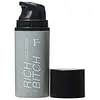What's inside
What's inside
 Key Ingredients
Key Ingredients

 Benefits
Benefits

 Concerns
Concerns

No concerns
 Ingredients Side-by-side
Ingredients Side-by-side

Water
Skin ConditioningCetyl Ethylhexanoate
EmollientGlycerin
HumectantPropanediol
SolventCocos Nucifera Oil
MaskingSqualane
EmollientButylene Glycol
HumectantCamellia Japonica Seed Oil
EmollientMethyl Trimethicone
Skin ConditioningLimnanthes Alba Seed Oil
Skin Conditioning1,2-Hexanediol
Skin ConditioningCetyl Phosphate
EmulsifyingOpuntia Ficus-Indica Seed Oil
EmollientDioscorea Japonica Root Extract
Skin ConditioningArginine
MaskingSodium Hyaluronate
HumectantOryza Sativa Bran Extract
Skin ConditioningHelianthus Annuus Extract
EmollientRosmarinus Officinalis Leaf Extract
AntimicrobialTocopherol
AntioxidantCetyl Alcohol
EmollientCaprylyl Glycol
EmollientParfum
MaskingSodium Polyacrylate
AbsorbentXanthan Gum
EmulsifyingSodium Phytate
Benzyl Salicylate
PerfumingHexyl Cinnamal
PerfumingLimonene
PerfumingAlpha-Isomethyl Ionone
PerfumingGeraniol
PerfumingWater, Cetyl Ethylhexanoate, Glycerin, Propanediol, Cocos Nucifera Oil, Squalane, Butylene Glycol, Camellia Japonica Seed Oil, Methyl Trimethicone, Limnanthes Alba Seed Oil, 1,2-Hexanediol, Cetyl Phosphate, Opuntia Ficus-Indica Seed Oil, Dioscorea Japonica Root Extract, Arginine, Sodium Hyaluronate, Oryza Sativa Bran Extract, Helianthus Annuus Extract, Rosmarinus Officinalis Leaf Extract, Tocopherol, Cetyl Alcohol, Caprylyl Glycol, Parfum, Sodium Polyacrylate, Xanthan Gum, Sodium Phytate, Benzyl Salicylate, Hexyl Cinnamal, Limonene, Alpha-Isomethyl Ionone, Geraniol
 Reviews
Reviews

Ingredients Explained
These ingredients are found in both products.
Ingredients higher up in an ingredient list are typically present in a larger amount.
1,2-Hexanediol is a synthetic liquid and another multi-functional powerhouse.
It is a:
- Humectant, drawing moisture into the skin
- Emollient, helping to soften skin
- Solvent, dispersing and stabilizing formulas
- Preservative booster, enhancing the antimicrobial activity of other preservatives
Arginine is an amino acid that is important for human development. Your body uses is it to produce hair keratin and skin collagen.
As a cosmetic ingredient, Arginine has antioxidant properties and can also help repair damaged skin. This ingredient is derived either synthetically or from animals.
Arginine isn't fungal acne safe when used in the presence of other lipids (fats, fatty acids, oils, esters, etc). Oils and fats occur naturally within the skin, so take caution when using Arginine if you're prone to fungal acne.
Learn more about ArginineButylene Glycol (or BG) is used within cosmetic products for a few different reasons:
Overall, Butylene Glycol is a safe and well-rounded ingredient that works well with other ingredients.
Though this ingredient works well with most skin types, some people with sensitive skin may experience a reaction such as allergic rashes, closed comedones, or itchiness.
Learn more about Butylene GlycolSodium Hyaluronate is hyaluronic acid's salt form. It is commonly derived from the sodium salt of hyaluronic acid.
Like hyaluronic acid, it is great at holding water and acts as a humectant. This makes it a great skin hydrating ingredient.
Sodium Hyaluronate is naturally occurring in our bodies and is mostly found in eye fluid and joints.
These are some other common types of Hyaluronic Acid:
Learn more about Sodium HyaluronateSodium Polyacrylate is the sodium salt of polyacrylic acid. It is used as an absorber, emollient, and stabilizer.
This ingredient is a super-absorbent polymer - meaning it can absorb 100 to 1000 times its mass in water. As an emollient, Sodium Polyacrylate helps soften and soothe skin. Emollients work by creating a barrier to trap moisture in. This helps keep your skin hydrated.